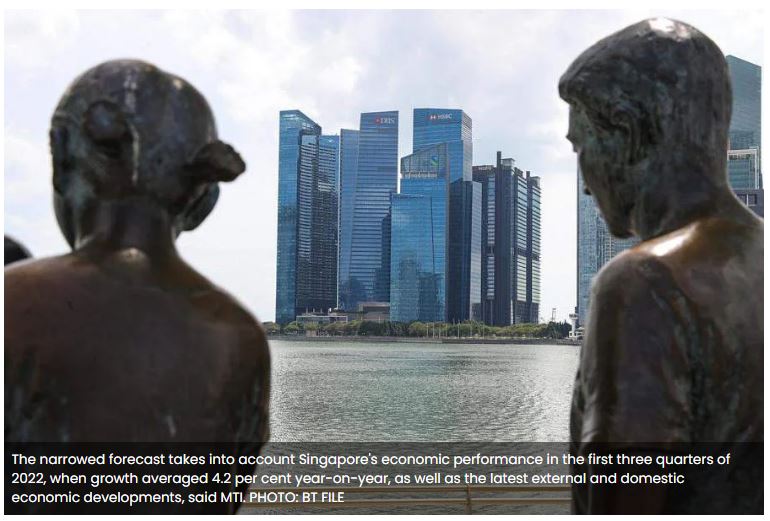Singapore’s 2023 growth forecast at 0.5-2.5%; 2022 forecast narrowed to ‘around 3.5%’
SINGAPORE’S economy is forecast to grow at between 0.5 per cent and 2.5 per cent in 2023, while the official full-year growth forecast for 2022 has been narrowed to “around 3.5 per cent”, according to a Ministry of Trade and Industry (MTI) release on Wednesday (Nov 23).
This follows the Monetary Authority of Singapore’s (MAS) previous forecast for gross domestic product (GDP) growth to slow in 2023 to a pace that is “below trend”.
For 2023, neither a full-year nor a technical recession is the authorities’ baseline scenario, MTI’s chief economist Yong Yik Wei told reporters in a morning press briefing.
But noting downside risks, she added: “We are expecting fairly flattish growth for the next one to two quarters, and obviously we would not rule out the possibility that in some quarters, we may dip into negative territory on a quarter on quarter basis.”
The updated forecasts come as third quarter growth was revised downwards to 4.1 per cent year-on-year, slower than both the earlier advance estimate of 4.4 per cent, and the 4.5 per cent growth recorded in Q2.
But on a seasonally-adjusted, quarterly basis, Q3 GDP was up 1.1 per cent on the quarter before, a reversal from Q2’s 0.1 per cent contraction, MTI said.
Meanwhile, the updated 2022 full-year forecast follows MTI’s narrowing of the forecast range in August to between 3 and 4 per cent, from a previous projection of 3 to 5 per cent.
The latest forecast of “around 3.5 per cent” takes into account the performance of Singapore’s economy in the first three quarters, when growth averaged 4.2 per cent year-on-year, as well as the latest external and domestic developments, said MTI.
“Since the last media briefing in August, the external demand outlook for Singapore has softened further due to the weaker outlook for the Eurozone amid an energy crunch, as well as for China as it continues to battle recurring Covid-19 outbreaks and a property market downturn”, said Permanent Secretary for Trade and Industry Gabriel Lim at the briefing.
This weaker economic outlook will thus weigh on the growth of Singapore’s outward-oriented sectors, including the key electronics and chemicals clusters, he said.
On the flipside, the strong recovery in air travel and international visitor arrivals is expected to continue uplifting the aviation- and tourism-related sectors, as well as consumer-facing sectors like food and beverage (F&B) services. The lifting of travel curbs in Singapore and the region has also boosted the recovery of the professional services sector.
For 2023, growth rates in most major economies are expected to moderate further from 2022 levels, with sharp slowdowns expected in the United States and Europe. “On the other hand, GDP growth in China is expected to pick up from a low base, but remain sluggish as the zero Covid policy is likely to continue to constrain household consumption,” said Lim.
In addition, global supply chain disruptions due to Russia’s war in Ukraine are expected to persist, though they may be less extensive and frequent.
At the same time, significant downside risks remain. These include rising interest rates in many advanced economies; financial stability risks if there are “disorderly market adjustments” to such monetary tightening; further escalations in the war in Ukraine; and geopolitical tensions among other major global powers.
As external demand deteriorates, the growth of outward-oriented sectors is expected to weaken further in the next year, said MTI. Semiconductor manufacturing is expected to be hit by a global fall in demand, and as these manufacturers cut back on capital spending, this may in turn hurt the machinery and systems segment of precision engineering. Growth is also expected to be dampened in sectors such as wholesale trade, water transport, and finance and insurance.
In a separate release on Wednesday, trade agency Enterprise Singapore upgraded its 2022 full-year trade forecasts for the third time this year, but predicted trade growth of -2 per cent to 0 per cent for 2023.
Nevertheless, some bright spots remain, said MTI. The aviation- and tourism-related sectors are expected to remain buoyed by the continued recovery of travel.
Asked about the inflation outlook, MAS chief economist Edward Robinson reiterated that inflation is expected to stay at an elevated rate “at least for the first half of the year”, barring further supply shocks.
Ahead of the next policy review due in April, MAS will “carefully examine all factors pertinent to inflation and growth conjuncture and outlook”, as well as the cumulative tightening moves since October 2021, he added.
Wednesday’s release also gave a sectoral breakdown of Q3 growth. Manufacturing grew by 0.8 per cent year on year, much slower than the 5.6 per cent growth in Q2. Expansions in transport engineering, general manufacturing and precision engineering offset declines in electronics, chemicals and biomedical output.
Construction growth picked up to 7.8 per cent, from 4.8 per cent previously, on the back of both public and private sector construction output.
The overall services sector expanded by 5.8 per cent, up from 5 per cent in the quarter before. F&B services saw the biggest increase, up 30.5 per cent year-on-year as sales volumes rose at food caterers, restaurants, cafes, food courts and other eating places.
Accommodation services was the only industry with negative growth, extending previous quarters’ contractions to shrink 1.9 per cent.
Source: https://www.businesstimes.com.sg/singapore/economy-policy/singapores-2023-growth-forecast-05-25-2022-forecast-narrowed-around-35


 English
English




